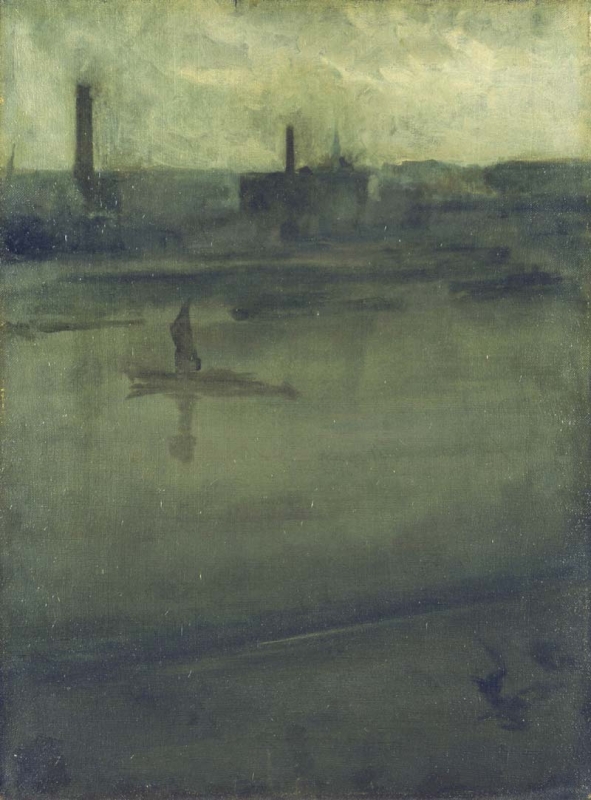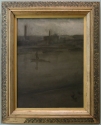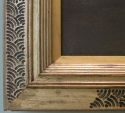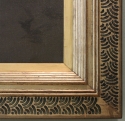Composition
It has been suggested that Whistler referred to this oil when working on his 1896 lithotint The Thames c161'. 1 This is not proven, but the relationship between these two is very close indeed, leading to a rethinking about the date of the oil itself.
Technique
Grey and Silver: The Thames was painted on a linen canvas, probably French, which has a very coarse open plain weave (11 and 13 threads/cm) and heavy glue size. 2
It has a distinctive placement of tacks on the tacking margins, with more tacks near the corners, and was primed after stretching. The thin grey priming that is present is probably Whistler’s, since it was applied only to the stretched canvas. It consists of lead white with significant amounts of chalk, and presumed bone black, in oil. The fibres are linen, and its dark and degraded state is an effect of oil-rich and medium-rich paint soaking into it. 3
It is an exceptionally cool, grey monochrome study. The buildings across the river are painted thinly and softly; the outlines are imprecise and merge into each other. The large chimney was tried out several times further to the right. The sky, with the brushstrokes going in every direction, was painted slightly more thickly. The paint on the river itself, and the barges on it, is nearly as thin as watercolour. Professor Townsend noted:
'The paint is very thin except where Whistler reworked the heavily clouded sky, down to the existing skyline. All of the original paint was thinned a lot; it includes only a little lead white and a lot of bone black, and was applied with a long soft brush that left many hairs in the paint. The reworked paint is unusually thick, also includes lead white and bone black, and was pastier than Whistler’s usual paint, which has made it trap air bubbles.' 4
Conservation History
It is unlined, with some areas of weakness and of strain on the canvas resulting in cusping. However, the paint and support are in sound condition. 5 The varnish is yellowed, giving the picture its current yellow/brown appearance. 6
Frame
ca 1878: partial Flat Whistler, painted seigaiha (waves) pattern.
This is not the original frame for this painting; it appears to have been constructed from left-over moulding or cut down pieces from another frame, at some date unknown. The reeded outer frame is missing, the seigaiha pattern is thick and mottled and does not run consistently around the image. The blank space, probably intended for a butterfly signature, is at lower left, but Whistler usually signed his frames at the side.
Notes:
1: The Hunterian website at http://www.huntsearch.gla.ac.uk (accessed 2016).
2: Prof. Joyce H. Townsend, Tate Britain, notes that C. W. Esckersberg used a comparable canvas in 1845, and this was likely a French canvas: examination report, June 2017. See Filtenborg, Troels, and Cecil Krarup Andersen, 'Canvas supports and grounds in paintings by C. W. Eckersberg', in Townsend, J. H., and A. Vandivere (eds), Studying the European Visual Arts 1800-1850: Paintings, Sculpture, Interiors and Art on Paper, London, 2017.
3: Technical analysis at Natural History Museum, London, for Townsend, 2017, op. cit.
4: Townsend 2017, op. cit.
5: Clare Meredith, condition report, 14 May 2001, Hunterian files.
6: Townsend 2017, op. cit.
Last updated: 21st October 2020 by Margaret










